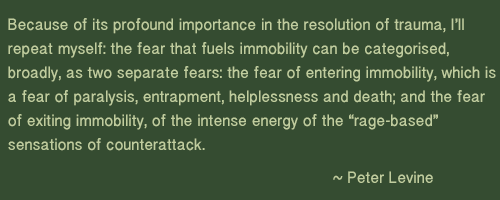Tonic immobility is evolution’s gift to us in order to keep us alive. Sometimes, in the face of threat and danger, it is safer to remain immobile or ‘play dead’, rather than fight or run. Sometimes fleeing or fighting are not even viable options, especially when we’re very young. We don’t make the choice not to move or not to call out for help voluntarily, this innate behavior and instinct is hardwired in us in order to ensure our survival.
As Peter Levine writes in his book In an Unspoken Voice: How the Body Releases Trauma and Restores Goodness:
As traumatised individuals begin to reown their sense of agency and power, they gradually come to a place of self-forgiveness and self-acceptance. They achieve the compassionate realisation that both their immobility and their rage are a biologically driven, instinctual imperative and not something to be ashamed of as if it were a character defect. They own their rage as undifferentiated power and agency, a vital life-preserving force to be harnessed and used to benefit oneself. Because of its profound importance to the resolution of trauma, I’ll repeat myself: the fear that fuels immobility can be categorized, broadly, as two separate fears: the fear of entering immobility, which is the fear of paralysis, entrapment, helplessness and death; and the fear of exiting immobility, of the intense energy of the “rage-based” sensations of counterattack. Caught in this two-sided clamp (of entering and exiting), immobility repels its antidote implacably so that it seems impossible to break through it. However, when the skillful therapist assists clients in uncoupling the fear from immobility by restoring “self paced termination of immobility”, the rich reward is the client’s capability to move forward in time. This “forward experiencing” dispels fear, entrapment and helplessness by breaking the endless feedback loop of terror and paralysis.

No comments:
Post a Comment